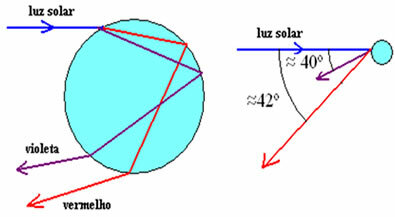Sometimes we observe a series of semicircular bands forming in the sky: it is the rainbow. Sometimes, when the air is very humid and the sun is close to the horizon, we can see a rainbow if we keep our backs to the sun. This is formed by the refraction and reflection of sunlight inside water droplets suspended in the atmosphere. As the refractive index depends on the color, sunlight scatters, separating the colors.
In the figure below we represent sunlight hitting a drop of water in the air. Upon penetrating the drop, the light is slightly scattered. We only represent the extreme colors: red and violet. The rays reflect on the inside of the drop, come back and undergo a new refraction, increasing the separation between the colors.
The emerging violet and red rays form angles of approximately 40º and 42º with the incident ray.

Rays emerging from the water drop
From the figure we can see that each drop sends out lights of all basic colors. However, because of the difference in angles, each color will be received, by our eye, from a drop located at a different height. That's why we see a set of colored semicircular bands, with the red band above and the violet below.
Sometimes there are two reflections inside the drop, as we can see in the figure below. In this case, we see the formation of a secondary rainbow, with light intensity lower than the primary rainbow. The colors are inverted, that is, violet light passes up and red light goes down.

Occurrence of two reflections inside the drop of water
By Domitiano Marques
Graduated in Physics
Brazil School Team


